Little Story
Last summer, met with Angie — we chatted about “cuteness” and she said wanna explore how cuteness can influence the virtual user experience. Her thoughts took me back two years ago when I instinctively felt the power of cuteness, but I was doubting whether it was a research topic worthy of exploration due to the lack of literature in HCI.
“I literally had the same idea as you two years ago, but I didn't start because not many people were exploring that," I said to Angie. She said, "yeah there is something for cute product design, but not for more general interaction design. let’s do it!”
Motivation
After conducting a literature review, we noticed that some HCI works have applied cute interfaces to AI agents, as well as to the physical and behavioral aspects of robots. These works rely on the 'Baby Schema' identified by ethologist Konrad Lorenz, using cuteness primarily as a form of decoration. In this project, we aim to explore ways in which artists and designers can contribute their cultural and aesthetic understandings of cuteness to create richer interactive experiences. We have built an interpretive framework that serves as a provocation for discussing the value of style in the design of interactive systems. This framework also provides guidance for defining cuteness building blocks to support interdisciplinary teams of artists, designers, and engineers in the creation of cute user experiences.

Step 1
We began with a cultural probe to identify some relevant cuteness factors. We collected 75 cute images from online sources (Tumblr, Pinterest, Giphy, and Etsy) and used text tagging to complete an initial qualitative assessment.
Step 2
After completing our initial artifact assessment, we discussed and grouped related cuteness factors to form our initial cute index. This process was informed by: Interviews and surveys with artists on their practice and cute expertise, our own observations and experiences with cuteness, eisting cuteness frameworks and a philosophical approach to aesthetics in HCI.
Step 3
We interviewed four artists to learn about their cute artistic practices. Each artist was chosen for their subject matter expertise in working with cute styles, based on social media hashtag searches and audience. We spoke to each artist about how they approach cuteness. We then asked each artist to tag 10 artifacts selected from the set of 75 used for our initial asssessment to expand our understanding of cuteness factors.

Step 4
In our final step, we synthesized our learnings to co-create cute building blocks with our engineers.

First, we mapped the cuteness factors from our updated and validated cute index into formal design elements.

We then worked with our engineers to translate cuteness factors into manipulable parameters. This process included an open format discussion of our identified aesthetic factors, cross-referenced with the images selected for assessment, and technical strategies for obtaining our desired visual outcomes.
In our case, we chose to work with Three.js, a Javascript powered WebGL engine that can display 3D graphics and 3D environments in the web browser for its manipulability and easeof-use when deploying ideas to playable virtual experiences.

Reflection
Cuteness is a style. The style can be represented by its aesthetic appearance, but what it brings can go beyond mere visuals, eliciting profound feelings. A cute application not only looks cute, but also has the power to rekindle our inner child. For me, cuteness is the "call" of my inner child. When I see cute things, I effortlessly project my "brave," "unfiltered," and "simple" inner child onto them, reminding myself to take care of that part of me while navigating this "complicated" world.
An application with style is akin to a vessel infused with a soul. If we aspire to create technology imbued with meaning, we might need to consider its style. As Zendi put it, 'Cuteness creates safeness. It offers the ability to maybe touch on tougher topics or be vulnerable in a way that you cannot in more intense mediums.' Similarly, Agatha observed that cuteness changes the way we perceive power dynamics. Cuteness seems to be a way to add more 'softness' to something sharp.
